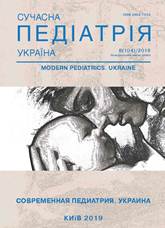Tonsilitis syndrome in children with acute epstein–barr viral infection
Keywords:
children, Epstein-Barr virus, infectious mononucleosis, tonsillitisAbstract
Objective. To study the clinical particularities of infectious mononucleosis (ІМ) in the children caused by Epstein–Barr virus with tonsilites and with colonized pathogenic microorganisms mucous membranes of the tonsils.Materials and methods. The medical records of 67 inpatient children up to 18 years of age who were treated with a diagnosis IM. Children were divided into 2 groups: with pathogenic microorganisms (group 1) and patients with negative results of bacteriological screening (group 2).
Results. A more severe course of the disease was observed in children with ІМ with colonized mucous membranes of the tonsils by pathogenic microorganisms. According to the results of a laboratory blood test, C-reactive protein, Antistrepolisin-O, Alaninaminotransferase levels were higher in the patients of group 1.
Conclusions. More severity of the disease was in the group of patients with acute tonsillitis of bacterial etiology. Factors associated with colonization of the tonsils by the pathogens are female sex, time of year, age, hepatomegaly, hyperthermia, and high levels of mononuclear cells in the blood.
The research was carried out in accordance with the principles of the Helsinki Declaration. The study protocol was approved by the Local Ethics Committee of Danylo Halytsky Lviv National Medical University. The informed consent of the patient was obtained for conducting the studies.
References
Deo PN, Deshmukh R. (2019). Oral microbiome: Unveiling the fundamentals. Journal of oral and maxillofacial pathology. JOMFP.23(1): 122–128. doi: 10.4103/jomfp.JOMFP_304_18
Fabrega-Ferrer M, Zhou D et al. (2019). Atomic structure of the Epstein–Barr virus portal. Nat Commun. 10: 3891. https://doi.org/10.1038/s41467-019-11706-8; PMid:31467275 PMCid:PMC6715670
Gomez A, Nelson KE. (2017). The Oral Microbiome of Children: Development, Disease, and Implications Beyond Oral Health. Microbial ecology.73(2): 492—503. https://doi.org/10.1007/s00248-016-0854-1; PMid:27628595 PMCid:PMC5274568
Greydanus D, Merrick J. (2019). Infectious mononucleosis: be aware of its lethality! International Journal of Adolescent Medicine and Health. 31(1). https://doi.org/10.1515/ijamh-2018-0284
Klein R. (2019). Infections of the Oropharynx Matthew. Emerg Med Clin N Am. 37 (2019): 69—80. https://doi.org/10.1016/j.emc.2018.09.002; PMid:30454781
Rostgaard K, Balfour HH Jr, Jarrett R, Erikstrup C et al. (2019). Primary Epstein–Barr virus infection with and without infectious mononucleosis. PLoS ONE 14(12): e0226436. https://doi.org/10.1371/journal.pone.0226436; PMid:31846480 PMCid:PMC6917282
Downloads
Issue
Section
License
The policy of the Journal “MODERN PEDIATRICS. UKRAINE” is compatible with the vast majority of funders' of open access and self-archiving policies. The journal provides immediate open access route being convinced that everyone – not only scientists - can benefit from research results, and publishes articles exclusively under open access distribution, with a Creative Commons Attribution-Noncommercial 4.0 international license (СС BY-NC).
Authors transfer the copyright to the Journal “MODERN PEDIATRICS. UKRAINE” when the manuscript is accepted for publication. Authors declare that this manuscript has not been published nor is under simultaneous consideration for publication elsewhere. After publication, the articles become freely available on-line to the public.
Readers have the right to use, distribute, and reproduce articles in any medium, provided the articles and the journal are properly cited.
The use of published materials for commercial purposes is strongly prohibited.

